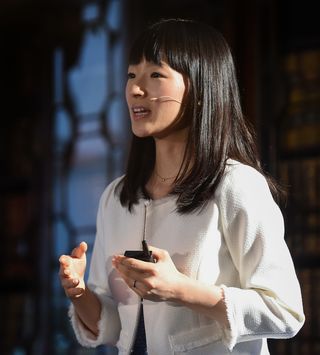Career
How to KonMari Your Writing
How tidying expert Marie Kondo can help you tackle your next creative challenge.
Posted October 3, 2019
Over the summer, I drank the Marie Kondo Kool-Aid.
If you’ve somehow managed to miss this (and if you have, please write me in the comments below and let me know your secrets for unplugging from pop culture), Marie Kondo is a Japanese tidying expert who is part-Mary Poppins, part-magical pixie, and has taken the world by storm in the past several years with her KonMari Method. Her books, most notably The Life-Changing Magic of Tidying Up, are worldwide bestsellers and her Netflix show, Tidying Up with Marie Kondo, has brought her further notoriety.

For those who haven’t read The Life-Changing Magic of Tidying Up, spoiler alert, the book is about much more than simply having a tidier home. Kondo’s approach is also a lens through which to view anything in your life, including your life itself.
As I got to know the KonMari Method, it struck me as a wonderful tool to help writers and artists answer a question they frequently ask me: How do I decide what I should work on next?
This fall, if you’ve got lots of projects vying for your attention and you’re struggling to figure out where to put your focus first, try walking through these KonMari-inspired steps:
1. Divide your projects and potential projects into categories. I suggest you group them by time-commitment:
a. Short-commitment (blog posts, articles, poems, and/or other pieces that you could draft in one or two sittings).
b. Medium-commitment (longer articles, short stories, essays, one-act plays, short film scripts, and/or other pieces you could draft over the course of between three and seven sittings).
c. Long-commitment (novels, memoirs, full-length scripts, and/or other pieces that would require your work over a more sustained period of time).
2. Once the projects are divided into categories, print out what you’ve got in each category (or find some more eco-friendly way to get it all in front of you at once).
3. Pick up each project and resist the urge to read anything you’ve written. Instead, hold it and sit with the weight of it. Allow yourself to focus completely on this one idea or piece for the moment, letting everything else temporarily fall away.
4. Notice how it feels to hold this piece of writing in your hands. Do you claim proud ownership of it or do you feel an impulse to put it aside? Does it feel heavy or light to you? Give yourself the space for whatever sensations and emotions bubble up as you hold each piece in your hands.
5. If a piece brings up any feelings of excitement in you, use your level of enthusiasm to help you rank your ideas in order of urgency.
6. If a piece doesn’t spark joy for you at all, take a moment to interrogate what that might mean. What has kept this project on your To Do list? It must have inspired you at some point—what changed? What’s turning it into a burden for you? Is it time to let this one go, knowing there are other ideas calling for you in a more urgent and exciting way?
As a creative artist, your brain (and your hard drive) have a much larger capacity than the limitations of a house or apartment, so when it comes to projects and ideas, you can hoard as much as you want. But that can make it easy for clutter to build up, muddling your focus and thwarting your efforts to prioritize. Your brain may be full of projects lingering around that have already served their purpose for your creative life and no longer require your attention. Letting them go can create space for you to cultivate something new, something that challenges you in ways you’ve never tried before.
And that’s the perfect way to kick off fall—by challenging yourself with some life-changing magic of your own.


